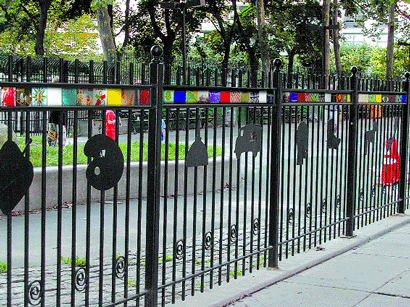Artists from around the globe collaborate on a tile project that will visit 22 cities
The row of tiles adorning a section of the fence around Mercer Park—on Mercer Street between Bleecker and West Third Streets—blends in well with the black metal onto which it is bolted. The vibrant array of colors likely catches the attention of passerbys, and there is something distinctly New York about the display. One tile depicts the entrance to a subway station. Another depicts a woman running to catch a train.
And yet, there are images that are clearly not related to the city; abstract pieces without a clear connection to urban life. Look closer, and the theme behind the installation, evocative of world peace and artistic collaboration, will be revealed.
The installation, a year-long exhibit that opened this November with hopes of finding a permanent home in the city, is but one of 22 installations throughout the world that are part of the “Tile Project,” an international endeavor spearheaded by the TransCultural Exchange, a Boston-based organization that aims to promote international communication between artists.
“This project is a call for peace,” explained Mary Sherman, the project’s director and founder of TransCultural Exchange. “I think of these installations as testaments of goodwill. While the world is in such strife, it’s amazing that artists around the world are willing to install each others’ work in their home countries without struggling with each other.”
The contributing artists faced a variety of hurdles to get installations set up in their respective countries, particularly in certain Eastern European states. Sherman recalled that her visit with artists in Romania aroused police suspicion, similar to an experience in Vietnam, where the tiles will be installed at the Museum of Fine Arts in Ho Chi Minh City.
“We had a lot of problems with [that] site because it’s a communist country and the installation could be shut down at any time without us being told,” said Sherman. “You forget that there are still places where artistic freedom is so restricted.”
“Artists don’t need to do this project to build their résumé,” said Sherman, a working artist. “They really believe that this kind of thing should be done.”
The global reach of the Internet, where the project was completed, made this artistic collaboration possible.
More than 100 artists created 22 tiles each, with each tile to be sent to one of 22 installation sites throughout the world from 2004 through 2006. Thus far, installations have already opened in Wales, New Zealand, Israel and Romania, as well as New York. Upcoming openings in 2005 include installations in Bosnia and Azerbaijan.
The artists had almost no design restrictions placed on them, except that each piece fit certain dimensions—4.25 inches by 4.25 inches, and a half-inch thick—in whatever medium. Some artists chose photography, others paint or glass.
“It was a whole exciting thing to wrap up a pile of tiles and send it off to a person you don’t know,” said Sherman. “And then, you get an e-mail back from them.”
She added, “Artists become great friends through this project. It’s what starts to get people talking to one another, because artists often are very insular.”
The resulting work is diverse in media, imagery and ideas, as are the installations themselves. Under the direction of the participating artists, each site bears local cultural traits with the one encompassing theme in the overall installation.
“The idea of doing something collaborative was very attractive to me,” said Enid Braun, a participating artist who co-directed the Mercer Park installation. “It just opens everything up. Everyone was friendly and excited.”
Karmela Berg, an Israeli artist who worked on the Tel Aviv site, also enjoyed the collaborative aspect of the “Tile Project.”
“I like to be involved with artists from different countries and different ideas and disciplines,” she wrote in an e-mail message. “This project was an opportunity to learn about so many people and their art.”
The Tel Aviv installation set out to develop an interdisciplinary approach to the sciences and art. Observing the reactions to the installation thus far, Berg wrote, “Students, professors and all people that saw it were intrigued and inspired. They stop, they look, they read [the tag underneath each tile identifying artist and country], and I think it does something to their soul. I wish I could install a camera to take photos of the reactions.”
Pan Ping-Yu, an artist in-volved in the Taipei installation that will open in May, also expressed a commitment to the notion of public art. She wrote via e-mail: “It shows that public art can do something different—more than functional, applied art. It brings the possibility of global understanding. I believe this understanding is priceless. The same goodwill of artists and art lovers from all over the world make it come true. I’m very happy to be part of this project and to work with other artists from all over the world.”
For her, this project is not simply about tile installations. “I think this project is also a miracle realized by ordinary people,” she wrote.
The “Tile Project” organizers hope to participate in the 2006 exhibition by the United Nations Educational, Scientific and Cultural Organization, or UNESCO, planned for Paris as a way to document the variety of ways the tiles have touched the world community.
gaycitynews.com

































